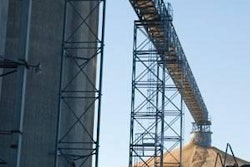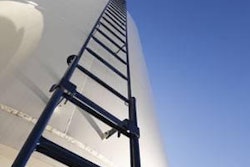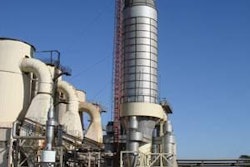
Aquaculture has become a significant driver of the whole feed manufacturing sector in the Asia region. While the production of pigs and cattle shows good growth regionally and poultry recovers from the blows inflicted by avian influenza, most of the Asian countries report a particular expansion of their capacity to make feeds for farmed fish.
Projects across the region continue to illustrate the rate of development. In Malaysia, for example, Thailand's agribusiness giant Charoen Pokphand has shown that aquafeed production is high on its agenda as it develops a strategy of expanding food-related investments abroad. The Malaysian aquaculture interests of Charoen Pokphand Foods (CPF) have been increased through a merger of two companies already connected to the group. Indirectly owned subsidiary Star Feedmills has paid 1.29 million Malaysian ringgit (about US$365,000) to buy the fish-feed assets of CP Jaya Farm. Further development is also planned by CP for a US$3 million aquaculture project that was started in China in 2004, the same year in which that CPF made its first fish farming investment in India. At the end of 2006 it also announced plans for a 144,000 tonnes/year feedmill in Laos to support poultry and pig production operations being started by new company CP Laos Co Ltd.
Vietnam offers more examples of the aquaculture influence. Fish production is being promoted there by the ministry of agriculture that quotes some tell-tale statistics. In a country with a coastline 3260 kilometres long, it says, one finds 112 estuaries and more than 4000 islands which form many bays, straits and lagoons. An additional 1.4 million hectares of fresh or brackish water and marine water surface are available for aquaculture purposes.
Local sources say it will be impossible to meet Vietnam's target for future aquaculture production up to 2010 without a considerable increase in the use of industrial feed. Expansion of mill numbers and capacity can be seen already, not least in the Mekong River Delta which is the heartland of the Vietnamese fish business with nearly 13,000 aquaculture farms, about 70% of the national total. Cultured production of river catfish has increased strongly in the delta over the last two decades. The provinces with the most production are Dong Thap and An Giang. They also have hatcheries and nurseries supplying districts close to the border with Cambodia. Local mill operators including French-backed Proconco have an expanding business in manufacturing feeds for fish grow-out sites. They will be joined shortly by New Hope from China. The biggest Chinese feed manufacturer major operator, which recently announced moves within China to increase its meat processing interests by buying a 60% stake in Beijing-based Qianxihe Food Co Ltd, is also reported from Vietnam to have bought land in Dong Thap as the location for a new aquafeeds plant.
Livestock production in Vietnam grew by 7.7% in 2006, according to the agriculture ministry, despite a 3% downturn for poultry output. Among other foreign companies recognising the feed potential in the country has been Cargill from the USA. Last year it commissioned its own aquafeed mill in the Mekong Delta. The US$5.5 million mill at Tra Noc, in Can Tho province, has a design capacity of 70,000 tonnes per year. What is more, Cargill general manager Scott Ainslie told local reporters that the company planned to build another 2-3 mills in Vietnam by 2010.
Reports at the time name Cargill Vietnam among the top players for feeds nationwide. The list also included Proconco, CP, uni-President from Taiwan and Vietnamese operator Cataco.
Both Proconco and New Hope will have sites in a newly developed Dinh Vu industrial zone that is slated for completion by 2010. About 100km from Hanoi, the northern Vietnamese site is in a favoured position by being close to fledgling international airport Hai Phong.
Philippines integrators add milling capacity
Enterprises controlling up to 80% of all broiler chicken production in the Philippines are currently either establishing or expanding their feed manufacturing interests, according to a new report on the country's poultry business.
Current and future prospects of the Philippine poultry industry 2006' has been prepared at the US Embassy in Manila and published as a GAIN report by the foreign agricultural service of the US department of agriculture (USDA). More can be seen at website http://www.fas.usda.gov/gainfiles/200612/146269818.pdf.
Poultry is big business in the Philippines, it points out. In recent times the poultry industry has made significant contributions to the national agricultural economy despite enduring repeated cycles of boom and bust as production fluctuated between the extremes of under-supply and over-expansion in response to the price levels of the moment. Chicken represents the fastest growing source of meat supply and demand nationally. Broiler consumption has nearly doubled over the last 15 years in line with rapid population growth, even though the amount eaten per person/year has stayed low at around 8 kilograms because of weak purchasing power.
Integrated producers organise themselves under the Philippine Association of Broiler Integrators (PABI), whose members include the historically dominant integrators such as San Miguel Foods, Swift Foods, Vitarich, Universal Robina Corporation and Tyson Bounty Agroventures. Of these, San Miguel Foods is rated the leader in terms of domestic market share at over 40%. The membership together is considered to represent 75-80% of the broiler meat supply.
The USDA report notes that San Miguel Foods contributes to over one third of the total commercial feed market. It says San Miguel and some other integrators have incorporated feed milling into their operations with the intention of ensuring both cost-effectiveness and consistent quality, while others have expanded their feed milling operations to produce mixed commercial feeds. There are concerns over production costs relating to feed efficiency at poultry production sites and to the world prices of imported feed ingredients, not the least corn.
Poultry production in the Philippines is highly import-dependent. The cost of Philippine broiler meat production is said to dwarf those of its counterparts in East and South East Asia as well as Latin America. Recent changes in the sector's environment including high and volatile production costs, along with the worries over highly pathogenic avian influenza (HPAI) in neighbouring countries, are reported to have led to key changes among the integrated producers. Some of them have reacted by expanding their output, whereas others have either closed down parts of their operation or resorted to toll servicing for various stages of the broiler production and marketing process.
Rise in imports
This development will have important implications for large and small producers alike, the USDA report contends. Current apprehensions on the part of producers have led to lower industry-wide production levels since 2005. This in turn has induced a rise in imported broiler chicken meat.
Moreover, there has been a re-shuffling of the roles of the integrators' organisation PABI, the United Broiler Raiser Association (UBRA) representing non-integrated producers and other commercial producers who do not belong to integrations. While some PABI members remain fully integrated, others have found it to be more profitable to halt operations after the production of day-old chicks and to contract-out the remaining production stages to independent growers while maintaining the mother company's name. Simultaneously, some UBRA members have found more profit in using integrated production methods. As a result, the report insists, future industry analysis will be required to qualify the role of companies that are integrated by affiliation (PABI) versus integrated by business type (in terms of the actual agribusiness model used).
The current situation is somewhat deceptive in nature, it comments. Although the general consensus indicates that integrated producers (in terms of business type) produce 75-80% of broiler meat in the Philippines, those who are members of PABI are believed to produce only between 65-70%. Various integrated broiler-producing agribusinesses are contracting out specific stages of the production process (such as the hatching of day-old chicks, grow-out and transportation) or the entire process beyond the chick, say industry players. This in turn has led to the increased role and responsibility of small and medium sized players in broiler meat production.
A new feedmill at Lligan in the Philippines is being built for Aboitiz Equity Ventures Inc at a cost of 200 million pesos. The 10,000 tonnes/month mill in Lligan City will be the second for the listed investment holding company of the Aboitiz family. The company expanded its existing mill at Tarlac in 2005.
Modernization is trend
China's animal production is in process of moving towards a modern system, from dated backyard farms, said deputy minister of agriculture Zhang Baowen at a forum held with the 2006 China Animal Husbandry Expo which took place in November in Dalian, north-east China. Animal production accounted for about 35% of the total value of China's agricultural output in 2005, he commented, and the sector employs over 100 million people. But there is still a large backyard segment. For example, about 70% of the pigs in China are from small farms with fewer than 100 head.
According to Zhang, a modern animal industry requires modern concepts, technology and facilities, as well as modern management. Specialised, larger-scale farms will be the trend of the Chinese industry in the future, he declared. The Ministry of Agriculture will support the animal industry towards modernisation in terms of finance and land.
Leading Chinese producers such as Shandong Liuhe Group also shared their experience in modernisation with over 400 attendees at the forum. Products for feed manufacturing were among exhibits from more than 500 companies at the expo, which has been organised annually since 2003 by China Animal Agriculture Association. The next edition is set for Ningbo, Zhejiang province, during 19th-21st May 2007.
Japan has seen a return to higher feed prices in 2006 after the average annual price dipped slightly last year. Data from the Japanese ministry of agriculture show prices of compound feeds to have been 8.1% above their year-2000 level in 2003 and 15.4% higher in 2004 before the increase dropped back to 12.1% in 2005. So far in 2006, says the ministry, monthly prices have remained between 14-15% more than in 2000.
China will become a net importer of corn within the next few years, according to an official at the Chinese ministry of commerce. In remarks quoted by a news agency, he indicated that purchases of maize to use in feeds, biofuels and other industrial processes were outstripping production nationally. Stocks of corn inside China have already fallen this year as a result of the domestic demand, he added.
Net importer status would represent a marked change for China, which exported 8.61 million tonnes of maize in 2005. Signs of the switch have been evident this year exports in the first nine months of 2006 were down by more than 68% at only 2.3 million tonnes. Initially there had been estimates that as much as 5 million tonnes of Chinese corn could reach world markets in the second half of the year. Meanwhile the January-September total for imported maize reached an unprecedented 60,000 tonnes.
Officials in Beijing insist that the changeover from net exporter to net importer will not happen as soon as 2007 because local supplies still exceed requirements. However, they believe the gap will disappear soon afterwards as more grain enterprises build processing facilities in China's major corn-growing provinces to convert their maize into the primary products of fuel ethanol, sugar and animal feed. Such processing activities consumed 15.6 million tonnes of corn in the first half of 2006, whereas the total for the whole of 2005 had been 25 million tonnes and in 2004 it was just 13.8 million. China is now the third-largest fuel ethanol producer after Brazil and the USA. Its ethanol and corn alcohol production consumed 8.9 million tonnes of maize last year, accounting for 44.5% of all industrial corn consumption.
Philippines department of agriculture plans to boost local production of feed grains including maize have been outlined to a meeting in Manila launching a national Corn for Health project. Agriculture secretary Arthur Yap said that the government would continue to expand and consolidate farms into clusters planted to hybrid corn, cassava and other feed crops. The intention is to create sustainable crop enterprises which can eventually be integrated with feed milling and livestock industries to result in affordable poultry and livestock products.
Unfortunately, he remarked, the Philippines is still a long way from being self-sufficient in corn production. Last year alone, it imported 930,000 metric tonnes of yellow corn and substitutes such as feed wheat in order to meet the increasing demand. Local output is rising, however. In 2006 the country is expected to post a record maize harvest of at least 6 million tonnes, up by 13.2% from last year's production of 5.3 million tonnes.
Reports from Tamil Nadu in India say that the agriculture department of the southern Indian state has embarked on a programme to increase by 50% the area of land under maize cultivation during the 2006-07 season, specifically to produce more corn for use by animal feed manufacturers. Official estimates suggest Tamil Nadu needs about 1.5 million tonnes of maize annually, but only about one-fifth of the demand is met locally. Feedmills therefore import from neighbouring states so that transportation adds to their raw material costs.
Tamil Nadu had approximately 200,000 hectares growing corn in 2005-06 and wants now to increase this to 300,000 hectares. The state's department of agriculture is also supporting a market intervention programme to ensure price stability for crop-growers, by encouraging contract farming programmes to involve feed manufacturers and integrated poultry units together with the National Agricultural Cooperative Marketing Federation. Loan facilities for maize growers have been extended by the Directorate of Agricultural Marketing to cover them against short-term low prices during the harvesting season.
Chinese feed growth detailed
Official Chinese data show China produced 46.4 million tonnes of compound feed in industrial mills in the first nine months of 2006. Premixes contributed another 15.4 million tonnes and feed additives some 3.15 million tonnes. The overall total of 65 million tonnes was 2.7% less than in the comparable period of 2005.
Chinese group expands
Further expansion on the Chinese market has been announced for AgFeed Industries Inc, which manufactures and sells animal feed in eastern China. Formerly known as Wallace Mountain Resources and incorporated in Nevada, USA, the corporation in October 2006 acquired Chinese feed manufacturers
Nanchang Best Animal Husbandry Co of Jiangxi province and Shanghai Best Animal Husbandry Co. In November it merged with AgFeed, previously its wholly owned subsidiary. Subsequently it has purchased all the shares of Guangxi Huijie Science & Technology Feed Co in Guangxi province for the equivalent of approximately US$1.09 million in cash. Guangxi Huijie makes and markets premixes, concentrates and blends, mainly in the southern provinces of China.
Grain alert in Pakistan
Feed prices for poultry production in Pakistan have increased by 15% in the past year, says the Pakistan Poultry Association, coinciding with a 25% increase in the cost of ingredients. Now the association is urging the Pakistani government to fix a support price for maize, sunflower and canola to help stabilise feed prices.
Production costs for chickens and eggs are higher in Pakistan than in other countries in the region, the association's chairman commented, and high fuel and energy prices are adding to the pressure on producers. For the first time in the history of Pakistan's commercial poultry sector, millions of broiler hatching eggs are being sold as table eggs every day at 50% of the production cost.
Pyongyang in North Korea is the site of the first foreign mill for north-east China's largest feed manufacturer. Wellhope Agri-tech Co Ltd reportedly has invested to produce 100,000 tonnes of mixed feeds and 10,000 tonnes of premixes annually from its new Pyongyang plant. Within China the Wellhope group has 35 subsidiaries and joint ventures. Within the past few months it has also started a joint venture in Nepal.
CP measures Thai feed output
Total feed production in Thailand is around 11 million metric tonnes per year, on estimates by the Bangkok headquarters of Charoen Pokphand (CP). The group itself has reported producing 5 million tonnes annually at its Bangkok Feedmill Ltd offshoot, with 3.2 million tonnes of that going to CP operations and the other 1.8 million tonnes to outside farms.
Diamond becomes feed supplier
Poultry integrator Diamond Hatcheries in India has developed a separate feed sales arm after completing the building of a new mill last year. The feedmill at Hyderabad has been operating since February and sells about 20% of the feeds it produces.
Betagro opens Thai mills
Meat integrator Betagro Group in Thailand has started 2007 by opening two feedmills in Lopburi province, taking its total number of Thai mills to eight. Betagro is now reckoned to account for 17% of all feed manufacturing output in Thailand by having a capacity to produce 1.5 million tonnes annually. One of the newcomer plants is rated at 45,000 tonnes/month producing broiler feeds for the group's own poultrymeat production sites. The other is an 8000 tonnes/month mill for aquafeeds and petfoods. Reports also describe a US$16.6 million plan for a 30,000 tonnes/month feedmill to be added in the north of Thailand in 2007, producing multi-species feeds for farm animals and pets.





.jpg?auto=format%2Ccompress&fit=crop&h=167&q=70&w=250)











